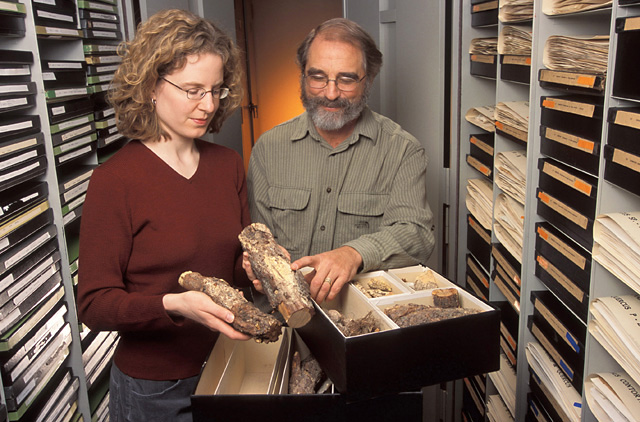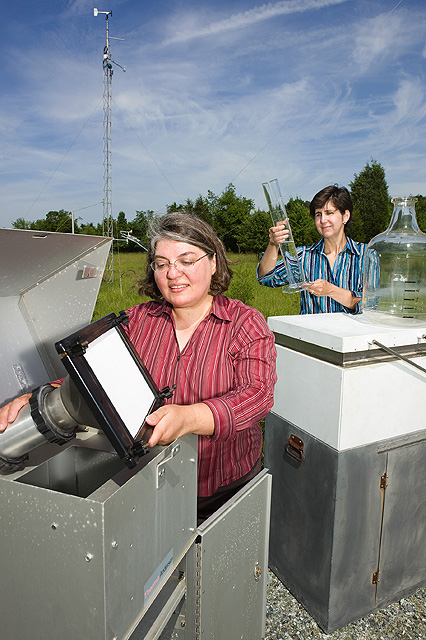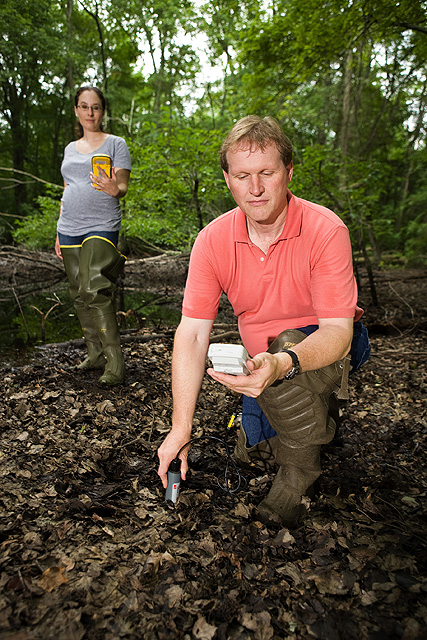Hot Research Topics 2010
Hot Topics Home
2015 | 2014 | 2013 | 2012 | 2011
2010 | 2009 | 2008 | 2007 | 2006
Agricultural Research Service Information Staff's Image Gallery - a complimentary source of high quality digital photographs
Systematics & Collections
 Plant Germplasm, Preserving Diversity, Insuring Our Future - If it were a museum, chances are it would be better known. But the U.S. National Plant Germplasm System (NPGS) is a vital network of genebanks where plants from around the world are curated, propagated, analyzed, and distributed for scientific use.
Plant Germplasm, Preserving Diversity, Insuring Our Future - If it were a museum, chances are it would be better known. But the U.S. National Plant Germplasm System (NPGS) is a vital network of genebanks where plants from around the world are curated, propagated, analyzed, and distributed for scientific use.
Most of the 511,000 samples, or accessions, of seeds, tissues, and whole plants are not on public display. They are kept at more than 20 Agricultural Research Service genebanks, many of which receive additional support from universities and state agricultural experiment stations.
Agricultural Research magazine, January 2010 Complete Article
 Marvelous Microbe Collections Accelerate Discoveries To Protect People, Plants-and More! - The U.S. National Fungus Collections and the National Rhizobium Germplasm Resource Collection are located at the Beltsville Agricultural Research Center. With more than 1 million dried specimens, the fungus collections are the largest of their kind. Scientists worldwide use them as a reference, and specimens are loaned for research projects.
Marvelous Microbe Collections Accelerate Discoveries To Protect People, Plants-and More! - The U.S. National Fungus Collections and the National Rhizobium Germplasm Resource Collection are located at the Beltsville Agricultural Research Center. With more than 1 million dried specimens, the fungus collections are the largest of their kind. Scientists worldwide use them as a reference, and specimens are loaned for research projects.
The Rhizobium collection provides a germplasm resource for industry to use in manufacturing inoculants and for researchers to use in investigating symbiosis and nitrogen fixation.
Agricultural Research magazine, January 2010 Complete Article
 Archiving Parasites and Protozoa for Research, Diagnoses, and More - In the United States, parasitic infections contribute to losses of more than $2 billion annually in livestock alone. In turn, some parasites, like tapeworm, can infect humans who eat uncooked or undercooked beef or pork.
Archiving Parasites and Protozoa for Research, Diagnoses, and More - In the United States, parasitic infections contribute to losses of more than $2 billion annually in livestock alone. In turn, some parasites, like tapeworm, can infect humans who eat uncooked or undercooked beef or pork.
Fortunately, ARS maintains archival collections of parasites for research, identification, and diagnostic purposes, the vast majority of which are held at the U.S. National Parasite Collection (USNPC), which is curated by ARS zoologist Eric Hoberg.
Hoberg is with the Animal Parasitic Diseases Laboratory, which is part of the Henry A. Wallace Beltsville Agricultural Research Center in Beltsville, Maryland. The collection was established in 1892 and is among the largest parasite collections in the world.
Agricultural Research magazine, January 2010 Complete Article
 Our Invaluable Invertebrate Collections - Many people find insects annoying. But to researchers, understanding these creatures plays a significant role in protecting American agriculture. That's why the Agricultural Research Service maintains invertebrate collections all over the United States.
Our Invaluable Invertebrate Collections - Many people find insects annoying. But to researchers, understanding these creatures plays a significant role in protecting American agriculture. That's why the Agricultural Research Service maintains invertebrate collections all over the United States.
Scientists use the invertebrate systematics collections, which are composed of preserved dead specimens, to help identify and verify insects and mites that are of economic importance and are used in research.
Agricultural Research magazine, January 2010 Complete Article
Historical Perspective
 Forum-At BARC, We've Only Just Begun - There's an easy way to keep an eye on what we're up to at the Beltsville Agricultural Research Center (BARC) these days. The Agricultural Research Service has around 900 active, appropriated research projects across the country, and a detailed description of each project is posted on the ARS website. And according to the in-house database we use for tracking our work, about 250 BARC researchers are either heading up or collaborating with more than 100 of these projects.
Forum-At BARC, We've Only Just Begun - There's an easy way to keep an eye on what we're up to at the Beltsville Agricultural Research Center (BARC) these days. The Agricultural Research Service has around 900 active, appropriated research projects across the country, and a detailed description of each project is posted on the ARS website. And according to the in-house database we use for tracking our work, about 250 BARC researchers are either heading up or collaborating with more than 100 of these projects.
Agricultural Research magazine, April 2010 Complete Article
 Celebrating 100 Years of Beltsville Agricultural Research - For the Henry A. Wallace Beltsville Agricultural Research Center (BARC), the year 2010 marks a significant moment in its history. The arrival of BARC's 100th anniversary is a time to commemorate past research successes, celebrate current research efforts, and anticipate future endeavors.
Celebrating 100 Years of Beltsville Agricultural Research - For the Henry A. Wallace Beltsville Agricultural Research Center (BARC), the year 2010 marks a significant moment in its history. The arrival of BARC's 100th anniversary is a time to commemorate past research successes, celebrate current research efforts, and anticipate future endeavors.
But this celebration is not just for BARC alone; it's a celebration for all of the Agricultural Research Service. You see, much of the research currently being conducted by ARS labs around the country originated at BARC.
Agricultural Research magazine, April 2010 Complete Article
Crop Diversity
 Help for the Common Bean: Genetic Solutions for Legume Problems - The common bean-which includes pinto, great northern, navy, black, kidney, and snap beans-is considered by many nutritionists to be a nearly perfect food because of its high protein content and low cost. But it is also susceptible to many diseases that reduce seed and pod quality and yields. Agricultural Research Service scientists from labs across the United States are playing major roles in finding solutions to what ails these legumes.
Help for the Common Bean: Genetic Solutions for Legume Problems - The common bean-which includes pinto, great northern, navy, black, kidney, and snap beans-is considered by many nutritionists to be a nearly perfect food because of its high protein content and low cost. But it is also susceptible to many diseases that reduce seed and pod quality and yields. Agricultural Research Service scientists from labs across the United States are playing major roles in finding solutions to what ails these legumes.
Agricultural Research magazine, May/June 2010 Complete Article
 Savinging America's Hemlocks - Hemlocks are popular, graceful trees well known to gardeners and landscapers. Unlike the poisonous herb made famous by Shakespeare and Socrates that goes by the same name, hemlocks are nonpoisonous, shade-tolerant, evergreen trees widely planted in backyards, landscapes, and gardens.
Savinging America's Hemlocks - Hemlocks are popular, graceful trees well known to gardeners and landscapers. Unlike the poisonous herb made famous by Shakespeare and Socrates that goes by the same name, hemlocks are nonpoisonous, shade-tolerant, evergreen trees widely planted in backyards, landscapes, and gardens.
Until recently, hemlocks have been very popular for landscape planting. But over the last few decades, the eastern and Carolina hemlocks have been under attack by a small sucking insect called the hemlock woolly adelgid (Adelges tsugae), or HWA. The insect, which is related to aphids, was accidently introduced from Asia and first observed in Virginia in 1951. It has since spread to forests and backyards in 17 eastern states, killing hemlock trees and devastating natural ecosystems.
Agricultural Research magazine, November 2010 Complete Article
 Public Gardens and ARS Working Together in Plant Preservation - Have you ever wondered what you would do if your favorite landscape plant was threatened to near extinction by a pest or disease? Well, it has happened several times throughout history and continues today. The recent and potentially catastrophic infestation of the emerald ash borer (Agrilus planipennis) has threatened to destroy native ash trees. Currently, sudden oak death (Phytophthora ramorum) is attacking oak trees in the West and threatens to spread to the rest of the country.
Public Gardens and ARS Working Together in Plant Preservation - Have you ever wondered what you would do if your favorite landscape plant was threatened to near extinction by a pest or disease? Well, it has happened several times throughout history and continues today. The recent and potentially catastrophic infestation of the emerald ash borer (Agrilus planipennis) has threatened to destroy native ash trees. Currently, sudden oak death (Phytophthora ramorum) is attacking oak trees in the West and threatens to spread to the rest of the country.
Since the beginning of the 20th century, the Agricultural Research Service and public and private cooperators have been working hard to ensure that we are better prepared to conserve these key components of our native forests, parks, gardens, and yards. In 1990, Congress reaffirmed its commitment to ornamental plant conservation by charging ARS with the enormous task of preserving highly valuable woody ornamental plant germplasm. It became apparent to ARS leaders early on that successful plant collection and preservation could not be accomplished without cooperation between the agency and public and private institutions.
Agricultural Research magazine, November 2010 Complete Article
Sustainable Farming
 Algae, A Mean, Green Cleaning Machine - Agricultural Research Service microbiologist Walter Mulbry has been finding out there's more to algae than just stringy masses that muck up streams and ponds. Though some scientists believe algae might be the next best thing in biofuel production, Mulbry thinks it can be used right now to reduce the nitrogen and phosphorus in livestock manure-and then dried and sold as a slow-release fertilizer.
Algae, A Mean, Green Cleaning Machine - Agricultural Research Service microbiologist Walter Mulbry has been finding out there's more to algae than just stringy masses that muck up streams and ponds. Though some scientists believe algae might be the next best thing in biofuel production, Mulbry thinks it can be used right now to reduce the nitrogen and phosphorus in livestock manure-and then dried and sold as a slow-release fertilizer.
Agricultural Research magazine, May/June 2010 Complete Article
 Rolling Rye; Guidelines Help Determine When's Best - Cereal rye is increasingly being used as a cover crop because it prevents erosion, helps the soil retain nutrients, and reduces the need to till the soil. Organic farmers also use cereal rye to help control weeds. When used as a cover crop, rye is planted in the fall, killed in the spring, and left to decompose. Then, soybeans and other cash crops are seeded through the dried-up plant residue, which forms a surface mulch.
Rolling Rye; Guidelines Help Determine When's Best - Cereal rye is increasingly being used as a cover crop because it prevents erosion, helps the soil retain nutrients, and reduces the need to till the soil. Organic farmers also use cereal rye to help control weeds. When used as a cover crop, rye is planted in the fall, killed in the spring, and left to decompose. Then, soybeans and other cash crops are seeded through the dried-up plant residue, which forms a surface mulch.
In some cases, farmers are opting to use a tool known as a "roller/crimper," which can flatten and kill an actively growing field of rye in a single pass. There are several designs, but most involve some type of rolling, paddle-wheel-like cylinder that attaches to a tractor and barrels over a field, tamping and crimping the rye into a smooth mat to kill it. The technology has been used for at least 15 years in small farms in South America and is slowly catching on in the United States, according to Steven Mirsky, an ecologist in the Sustainable Agricultural Systems Laboratory in Beltsville, Maryland.
Agricultural Research magazine, November 2010 Complete Article
Nutrition
 Diabetes: Nutrition Research Tackles Widespread Disease, Extracts Hold Potential - In Maryland, ARS researchers have published findings that suggest certain spices may be beneficial to some people with diabetes. Chemist Richard Anderson, at the Beltsville Human Nutrition Research Center (BHNRC), and colleagues are studying water-soluble extract of cinnamon.
Diabetes: Nutrition Research Tackles Widespread Disease, Extracts Hold Potential - In Maryland, ARS researchers have published findings that suggest certain spices may be beneficial to some people with diabetes. Chemist Richard Anderson, at the Beltsville Human Nutrition Research Center (BHNRC), and colleagues are studying water-soluble extract of cinnamon.
Among several diabetes-focused studies conducted and published in the last 5 years by BHNRC researchers, one involved looking at a potential interplay between the extract and insulin or blood glucose levels. Insulin is a key hormone that "opens a door" within cells and then escorts glucose into those cells, thus providing fuel to them. Without a sufficient insulin supply, or ability to use available insulin, glucose builds up in the blood instead of going into cells where it can be metabolized and used for fuel. Over time, damage occurs to the eyes, kidneys, heart, and nerves.
Agricultural Research magazine, July 2010 Complete Article
Invention May Help Improve School Lunch - National School Lunch Week is being held this month, and Agricultural Research Service (ARS) researchers have provided another reason to celebrate-a new technology that holds promise to make students' mealtimes safer and more appealing.
It all started several years ago when school food-service personnel noticed that there were too many bone fragments in poultry used to make meals for the National School Lunch Program. The National School Lunch Program is a federally assisted meal program operating in public and nonprofit private schools and residential child-care institutions. About 31 million children participate in the program each weekday during the school year.
Agricultural Research magazine, October 2010 Complete Article
Chesapeake Bay
 ARS Chesapeake Bay Research Intensifies - The Chesapeake Bay faces many threats-from the pesticides and fertilizers used to grow corn, soybeans, and other crops, to pollution from wastewater-treatment plants, cars and boats, and poultry production.
ARS Chesapeake Bay Research Intensifies - The Chesapeake Bay faces many threats-from the pesticides and fertilizers used to grow corn, soybeans, and other crops, to pollution from wastewater-treatment plants, cars and boats, and poultry production.
Agricultural Research Service scientists have contributed to the effort to clean up the bay for more than two decades. Most recently, ARS scientists in Beltsville, Maryland, conducted a comprehensive study of pollutants at seven spots in the Choptank River, a major bay tributary that faces the same threats.
Agricultural Research magazine, August 2010 Complete Article
 Forested Wetlands in the Chesapeake Bay Watershed - A clear view through the trees. That's what soil scientist Greg McCarty and USDA Forest Service ecologist Megan Lang have been working towards as they pioneer the merging of two remote sensing technologies to map forested wetlands in the Chesapeake Bay Watershed.
Forested Wetlands in the Chesapeake Bay Watershed - A clear view through the trees. That's what soil scientist Greg McCarty and USDA Forest Service ecologist Megan Lang have been working towards as they pioneer the merging of two remote sensing technologies to map forested wetlands in the Chesapeake Bay Watershed.
McCarty and Lang are based at the ARS Henry A. Wallace Beltsville Agricultural Research Center in Maryland, and they conduct research on the bay's Eastern Shore, which is located on the Delmarva Peninsula that juts between the bay and the Atlantic Ocean. Delmarva is an acronym for Delaware, Maryland, and Virginia-the three states that make up the peninsula.
Agricultural Research magazine, August 2010 Complete Article
 Chesapeake Bay Cleanup Revs Up! - President Barack Obama's May 12, 2009, Executive Order on Chesapeake Bay Protection and Restoration directed federal agencies to clean up the bay and to promote reliance on adaptive management to increase environmental benefits.
Chesapeake Bay Cleanup Revs Up! - President Barack Obama's May 12, 2009, Executive Order on Chesapeake Bay Protection and Restoration directed federal agencies to clean up the bay and to promote reliance on adaptive management to increase environmental benefits.
This management approach means using ecosystem monitoring, with rapid feedback, for improved decisionmaking in managing land to reduce pollution of the bay.
The Agricultural Research Service's merging of remote-sensing, field-sampling, and farm-program records to judge the effectiveness of winter cover crops in controlling nitrogen losses from fields fits the bill in several ways. It is the type of use of advanced monitoring tools the order calls for, with many rapid feedback loops to allow adjustments each fall, when winter cover crops are planted in the bay area. Winter cover crops are an important practice for capturing nitrogen left over from fall-harvested crops before it can pollute the bay.
Agricultural Research magazine, August 2010 Complete Article
